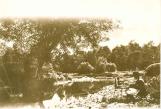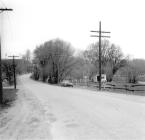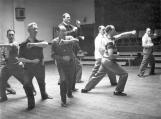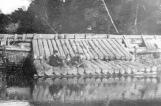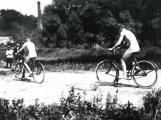1
The serene beauty of the Don Valley has inspired artists for more than two centuries.3
Painting in the ValleyThe late eighteenth-century watercolours of Elizabeth Simcoe are some of the earliest preserved works depicting the Don Valley.
Much later, the Valley would serve as the inspiration for the etchings and paintings of Owen Staples.
5
In the 1940s, a small group of East York artists began to meet and paint together. As the group grew, the Borough of East York granted it squatters' rights to a piece of land at the foot of Don Mills Road at a rate of $1.00 per annum. While the group constructed its own cabin, its members met at neighbour Charles Sauriol's home.The group came to be known as the Don Valley Art Club (DVAC). In 1949, DVAC held its first public exhibit. Works were displayed inside their cabin and, weather permitting, outdoors on a fence. The group met weekly, inviting demonstrations from renowned Canadian artists such as Lismer, Bayefsky, Franck and Varley.
A monthly newsletter was produced and sent to all DVAC members. Membership in the group continued to grow and in the winter of 1952, the size of the club house was tripled.
7
In 1967, East York Mayor True Davidson invited the members of the Don Valley Art Club to move into the renovated Paper Mill at Todmorden Mills Museum. The Club sold its building and contributed the profits of the saleto the renovation of the Museum.
The Don Valley Art Club moved its studios into the Todmorden Paper Mill in 1975.
9
East Side Players - Theatre in the ValleyThe East York Players, a community theatre group, was established in 1965. Within two years, the group merged with the Leaside Players to create a new company, the East Side Players. Rehearsals were held at the Pape Avenue Community Centre, while performances were presented at the George Locke and Central Libraries.
By 1974, when the restoration of part of the Todmorden Paper Mill was complete, Mayor True Davidson invited the East Side Players to relocate to this space where they could rehearse and perform under one roof. When the north portion of the Paper Mill was restored two years later, the East Side Players relocated to it.
This vacant space was transformed into a theatre, designed by then-president Vern Bock.
The fundraising efforts of the East Side Players provided the theatre stage and curtains, seating, lighting, sound equipment as well as a dressing room.
The East Side Players became one of the foremost community theatres in the Toronto area, producing accessible comedy and drama events, many by award-winning playwrights.
11
Swimming in the Don RiverThe Don River was a favourite swimming spot for generations of children and adults.
Most deep places in the Don River provided a swimming hole but several were particularly well known. One was located just north of the Bloor Street Viaduct; another just above Pottery Road at Taylor's dam.
In the 1950s, the Don River was re-channelled to accommodate the construction of the Bayview Extension and the Don Valley Parkway and most of these swimming holes disappeared.
13
The "Sandy Point" or "Willows" swimming hole was particularly favoured by the local residents. Boys often tied ropes to the high branches of the tall willows that lined its banks, and swung across the Don.The popular swimming hole inspired these lyrics, sung to the tune of "The Blue Bells of Scotland":
"Oh where, tell me where did the Yorkville boys swim,
Oh where, tell me where did the Yorkville boys swim,
In the Don at Sandy Point beneath old Sugar Loaf Hill
Near Helliwell's Bush and Castle Frank across from Taylor's mill."
Swimming trunks were optional!
